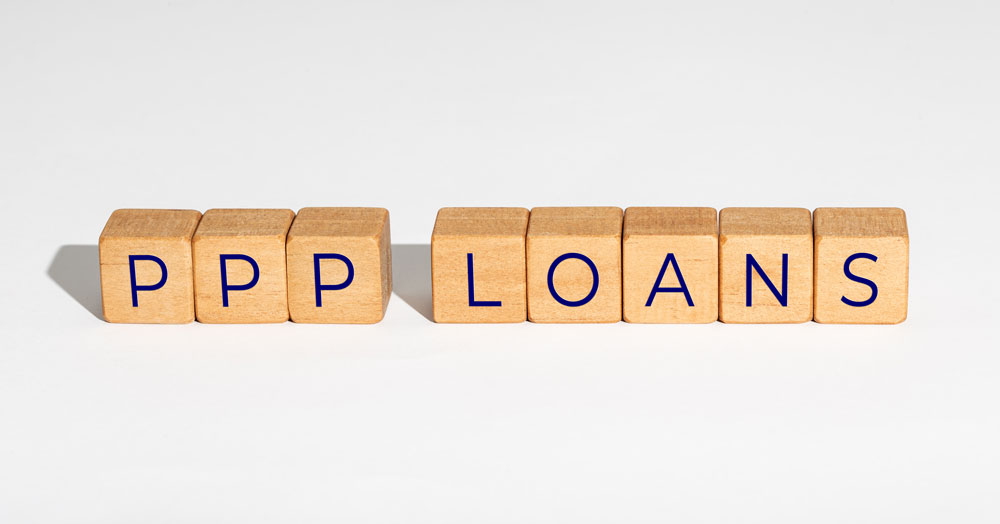
Nearly 12 million loans were issued under the Paycheck Protection Program (PPP), according to ProPublica. This amounts to some $799 billion disbursed, of which $395 billion has already been forgiven. But if your business is one of the many borrowers who still have an outstanding loan, you undoubtedly have questions about whether you qualify for PPP forgiveness and how to get the ball rolling if you do.
We’ll go over general details of the loan forgiveness process below, but defer to your lender for guidance specific to your particular loan.
What is PPP Loan Forgiveness?
Now closed to new loan applications, the PPP loan program was established as part of the CARES Act to help businesses weather the COVID-19 crisis and keep more people employed. Overseen by the SBA (Small Business Administration), the program took effect at the end of March 2020 and allowed business owners to submit a PPP loan application valued at 2.5 times their average monthly payroll costs.
The rules were changed slightly in June 2020 with the Paycheck Protection Program Flexibility Act and again in December 2020 when additional funding was added and the second draw loans option was created.
PPP loans were issued with the understanding that business owners who qualified and spent most of their PPP funds on payroll would be able to apply for forgiveness at a later date. This made the loans function more like grants than money that needed to be paid back.
Now that the window for forgiveness is open, many businesses are applying to have their loans forgiven and wiped away.
Expenses Eligible for Loan Forgiveness
Eligible payroll and non-payroll costs. Initially, only payroll and operating costs counted as eligible expenses. However, the types of costs as of December 2020 include a number of additional non-payroll expenses.
Payroll Costs
Compensation for employees clearing $100,000 per year isn’t eligible for forgiveness, nor are payments to independent contractors, as they could apply for their own loans. However, the guidelines leave quite a bit open beyond that, including:
- Wages
- Salary
- Tips
- Commissions
- Insurance
- Disability
- Sick Leave
- Retirement Contributions
Operating Costs
A few examples of forgivable expenses that fall under the operations expenditures umbrella include:
- Mortgage Payments and Interest
- Business Rent or Lease Payments
- Utilities
- Business Software (for accounting, payroll, inventory, etc.)
Supplier Costs
If you had a purchase order in place before your covered period (typically an 8- to 24-week covered period), you might also qualify for forgiveness on general goods essential to operating your business. In addition, if you purchased perishable goods during the covered period, these may also be included.
Worker Protections
Businesses that had additional expenses related to complying with health and safety requirements can also include them. A few examples are:
- Personal Protective Equipment PPE
- Installation of Barriers
- Expansion of Outdoor Dining
- Health Screenings
Property Damage
If your business required repairs or had losses related to looting that can be directly attributed to public disturbances in 2020 that were not covered by your insurance, your property damage costs may qualify for forgiveness as well.
Requirements for PPP Loan Forgiveness
Be sure to check your “covered period” or “alternative payroll covered period,” as this will determine whether your expenses qualify or not. Generally speaking, if you paid for the expense during the covered period, it would qualify even if it was incurred beforehand. However, if you waited until after your covered period ended to pay the expense, it must have been paid by the next regular billing or payroll date.
When to Apply for PPP Loan Forgiveness
There are two windows to be concerned with: the day your first payment is due and the day your loan matures.
Payments are deferred ten months after your covered period ends. At this point, you’ll need to start making payments on the loan.
If your PPP loan originated before June 5, 2020, your loan matures two years after. If your loan originated after June 5, 2020, you have a five-year maturation span.
The hard cutoff for applying for PPP forgiveness is when your loan matures, but you’ll likely want to apply before payment is due if you intend to apply at all, as this will keep more money in your pocket.
How to Apply for PPP Loan Forgiveness
There are three applications for loan forgiveness. The right one will vary based on your situation.
- Form 3508EZ: For self-employed individuals with no employees and those who did not reduce employee headcount or wages.
- Form 3508S: For businesses that received $150,000 or less in PPP funds.
- Form 3508: All other businesses that received PPP funds.
Documentation Needed for PPP Loan Forgiveness
To qualify for full forgiveness, at least 60 percent of your loan proceeds must be spent on payroll, and only funds spent on allowable expenses can be forgiven. With this in mind, you’ll need to send supporting documentation with your PPP loan forgiveness application to prove how you spent the funds. A few examples are highlighted below.
Payroll Expense Documentation
- Third-Party Payroll Reports
- Bank Statements
- Tax Forms
- Form 1040 Schedule C or Schedule F
- Form 1065 Schedule K-1
- Form 941
- Form 944
- Form W-2
- Form W-3
- State and Local Quarterly Financial Reports
- State Unemployment Insurance Filings
- Proof of Qualifying Employee Benefits
- Payment Receipts
- Account Statements
- Canceled Checks
Non-Payroll Expense Documentation
- Purchase Orders, Contracts, or Receipts
- Utility Bills/ Proof of Utility Payments
- Account Statements
- Proof of Qualifying Non-Payroll Expenses (PPE, damage, etc.)
- Payment Receipts
- Account Statements
- Canceled Checks
Additional Loan Forgiveness Tips for Applicants
Don’t Reduce Your Forgiveness Amount if You Don’t Have To
Because the PPP program was intended to keep people on the payroll, businesses that laid off, furloughed employees, or terminated full-time equivalent (FTE) employees or cut their wages by more than 25 percent will generally have their forgiveness amount reduced.
To determine if a reduction has been made, employers will use a reference period as outlined below:
- February 15 to June 30, 2019
- January 1 to February 29, 2020
- A consecutive 12-week period between May 1 and September 15, 2019, for seasonal employers
If you have FTE reductions, you may still qualify for full forgiveness, as there are three exceptions or safe harbors available.
- If compliance with government directives prevents you from operating at the same level you were before February 15, 2020, you don’t need to claim any full-time equivalency deductions.
- If you restored FTE employees before December 31, 2020, or by the end of your covered period if your loan was made after December 27, 2020, you don’t have to calculate reductions.
- If you restored wage levels before December 31, 2020, or by the end of your covered period if your loan was made after December 27, 2020, you don’t have to calculate reductions.
In addition to these guidelines, businesses may also be exempt from reducing their forgiveness amounts if:
- The PPP loan was $50,000 or less.
- The employee requested the reduction, resigned, or was fired with cause.
- You offered to restore the employee’s hours at the same hourly wage or salary in good faith, but the employee declined or did not respond.
It’s worth noting that you should also include documentation to prove any of these scenarios with your forgiveness application.
Don’t Short Yourself on Allowable Payroll Costs
Remember, a multitude of payroll costs count toward your loan, so look for additional expenses like leave, retirement plans, and insurance, too.
Focus Most of Your PPP Loan on Payroll
To qualify for full loan forgiveness, 60 percent of your loan must have been spent on payroll. So, when you’re gathering documentation to show how money was spent, prioritize this expense first. If you spent less than 60 percent on payroll, your calculation should show the forgivable amount reducing correspondingly. For example, if your full loan was $100,000, you’d need to have spent $60,000 on payroll to qualify for full forgiveness. But let’s say you only spent $50,000 on payroll. That’s 83 percent of the required amount, so rather than qualifying for a full $100,000 forgiveness, you’ll qualify for $83,000 forgiveness.
Be Prepared to Move Forward without Loan Forgiveness
You may not qualify for some or all the forgiveness you hope for, so don’t run your business expecting to receive forgiveness. Thankfully, interest is just one percent, and you have a considerable amount of time to pay it. Plus, there are deferment options for those who are struggling when payment comes due.
Boost Your Cash Flow without Debt
If your business is struggling while you wait for PPP forgiveness or as you make payments, invoice factoring can help by accelerating payments on your B2B invoices. Request a free rate quote to get started.
Frequently Asked Questions About PPP Loan Accounting and Forgiveness
How should a PPP loan be recorded on the balance sheet before forgiveness?
Under Generally Accepted Accounting Principles (GAAP), Paycheck Protection Program (PPP) loans are usually treated as short-term debt until officially forgiven. This means the loan amount should be listed as a liability on your balance sheet. Depending on your accounting policies, you may also need to record interest, even if no payments are due yet.
Can a PPP loan be accounted for as a government grant?
In certain cases, businesses may choose to apply International Accounting Standard (IAS) 20, which allows the loan to be treated as a government grant if specific forgiveness criteria are met. This approach involves recording the expected forgiven amount as deferred income, meaning income that is recognized gradually. Be sure to consult a Certified Public Accountant (CPA) before using non-U.S. accounting methods.
When can a business recognize PPP loan forgiveness in financial statements?
You can recognize loan forgiveness once all forgiveness requirements have been met and your lender and the Small Business Administration (SBA) confirm approval. At that point, the loan is considered extinguished, and you can remove it as a liability and report the forgiven amount as a gain, usually listed under “other income.”
Is a forgiven PPP loan taxable income?
At the federal level, forgiven PPP loans are not considered taxable income, according to current IRS guidelines. However, tax treatment may differ by state, especially in states that do not fully align with federal rules. Businesses should check with a CPA to understand local tax laws and whether related expenses remain deductible.
How do you properly account for PPP loan proceeds under GAAP?
Under GAAP, PPP loan funds are typically recorded as a cash inflow from financing activities on your statement of cash flows. Until the loan is forgiven, it remains a liability. Once forgiveness is confirmed, you record a debt extinguishment, which means removing the liability and reporting the forgiven amount as income, depending on the timing and details of the approval.
- Business Financial Literacy Guide for Owners and Decision-Makers - November 25, 2025
- Full Guide to Factoring for Temporary Staffing Companies - October 10, 2025
- Why Early Payment Programs Are the Future of the Construction Industry - August 19, 2025

